Human Development and Family Sciences
Student Research Posters: Relationships/COVID-19
Click on the accordions below to view student research posters from HDFS-333 Development of Human Relationships. This course focuses on developmental theory and research related to intrapersonal and interpersonal conditions, characteristics, attitudes and behaviors necessary for effective human relationships.
Have questions or comments on these research posters? Please email Layne Humphrey.
The Changing Tides: Analyzing the Impact of COVID-19 on Familial Relationships
Oyku Gurman, Claudia Kurtz, Aaron O’Doherty, Abbi Peffley, Tymber Powell, Lexie Skor
Background
University of Delaware students underwent a stay-at-home order in March 2020, This had varying impacts in our survey population: 82 total survey responses with 98.8% of responders living with a relative or significant other from March through June 2020.
Research Question
What are the social impacts on UD students regarding immediate familial relationships made by the presence of COVID-19 during March through June 2020?
Methods
- Four quantitative questions
- One qualitative question, “In what ways have your overall feelings towards your immediate family members changed during COVID-19 from March to June 2020?“
- All responses were collected from HDFS 333: Development of Human Relationships students during Fall 2020. Approximately 60% were seniors, 20% juniors 11% sophomore‘s or freshman
Results
-
What were your overall feelings towards your immediate family members
-
Before March 2020?
-
Very positive 52%
-
Somewhat positive 22%
-
Neutral 11%
-
Somewhat 3%
-
-
After June 2020?
-
Very positive 53%
-
Somewhat positive 22%
-
Neutral 4%
-
Somewhat 5%
-
Very 1%
-
-
-
Identified trends from our collective qualitative data we were able to do identify several trends, the main to trends being:
-
High retention of positive experiences
-
Increased feelings of being trapped
-
Increased arguments and tension between family members
-
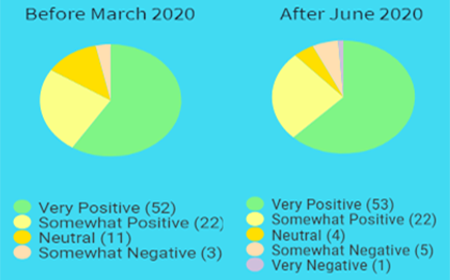
Notable Quotes
- “The lack of separation from anyone in the family made it feel like I had no escape, so the main difference is that before I would have been very excited to go home and see my family where is now I cannot get away.”
- “I feel more distant to my parents because I was around them so much and we got into fights that never ended in fixing anything.”
- “I feel as if my relationship with my family has become worse since quarantine. Living on top of each other or not being able to socialize was difficult. We used to never argue and in quarantine we would all argue more than ever.”
- “Being around my family constantly for months on end was difficult because I was seeing the same people every day with no escape to see other people and have a break.”
Conclusion
- The majority of students had positive emotions towards their immediate family members and continue to have them after the initial at impacts of COVID-19.
- However, there was a pull toward negative experiences that is just as important to identify – this reflects how each family unit is equipped differently when handling outside stressors like a pandemic.
- It is essential to talk about the resilience of family units and look at how our relationships are impacted by external and internal forces. COVID-19 did have an impact on family will relationships in some regard.
Communication, Closeness, and COVID-19
Nancy Allyon, Maddie Campbell, Alex Goodman, Colin Mattia, Farshuan Sudler
Abstract
We are seeking to find quantitative and qualitative data regarding students living situations and how COVID-19 has impacted their relationships specifically we are looking for data regarding perceived closeness and communication tendencies between students and those with whom they quarantined.
Challenges
- “Due to the fact that I was with my family and all my siblings are in school finding a quiet place that I could be unbothered doing schoolwork was one of the biggest challenges being quarantined.“
- “Being around each other too much caused us to get annoyed with each other and we would get into small arguments sometimes.“
- “The biggest challenge was finding time for myself. I was home with my family so we spent almost all our time together. I enjoyed this because I am close with my family and it gave me something to keep busy but in those times I needed space, I was unable to find it.
Data
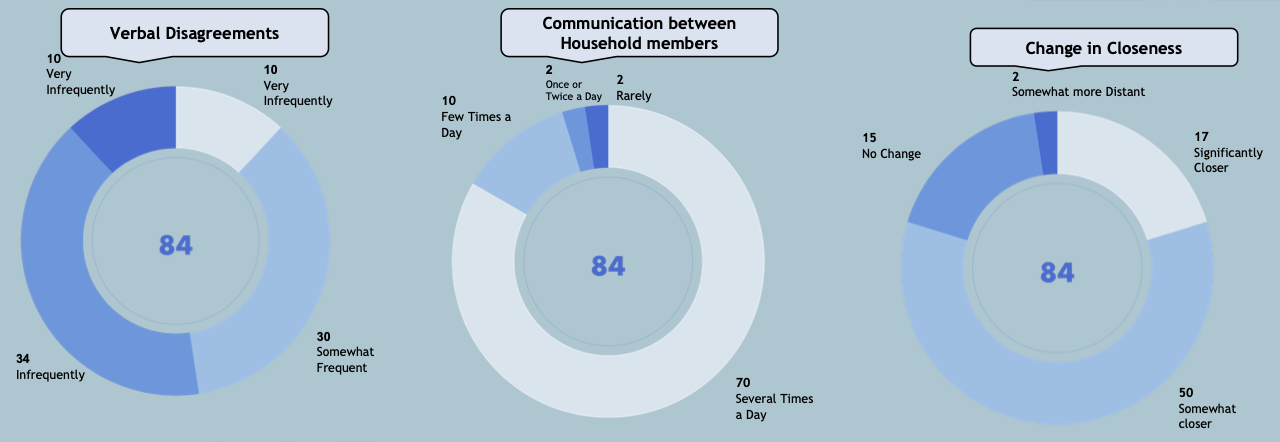
Conclusion
In conclusion we found there was no statistically significant correlation between the frequency of verbal disagreements and communication frequency perceived closeness or activities performed. However, roughly 80% of respondents felt closer to whom they quarantined with. Also, an overwhelming majority of respondents communicated and participated in activities with the same individuals. This leads us to believe that COVID-19 quarantine has led to a higher level of perceive closest and communication.
Coronavirus: Conflict Chaos
Anya Dunigan, Ana Mellos, Bryanna McNamee, Jack Lavelle, Samantha Randis
Abstract
The purpose of this survey is to analyze conflict resolution before and during COVID-19. The focus is around how individuals communicate with their families, as well as the comfort level when addressing conflict. We found that resolution styles can change which impacts family communication and dynamic by learning to cope with conflict during stressful times in a confined space.
Background
- As we continue to see nationwide efforts to reduce the spread of coronavirus, many families across the country have been adapting to increased time at home.
- College students are accustomed to a level of autonomy and independence that can be extremely difficult to lose when returning home.
- Change in normal social routines can lead to anxiety and feeling lonely and result in feelings of tension within a family.
- Conflicts may emerge between parents and their children related to expectations about structure and routine and time spent with friends versus family.
Methods
- Data Set→ The survey and its questions were given to undergraduate students at the University of Delaware currently enrolled in HDFS 333.
- Data Collection→ Used “Google Surveys” to collect data and responses from our set of respondents. Data included both multiple choice responses and open ended responses.
- Analysis→ By examining the responses of those who completed the survey we were able to draw conclusions about commonalities and differences of students experiences during their quarantine period of COVID-19.
Results
- When asked if the frequency of conflict has changed since COVID-19 started, we found:
- 6% significantly more frequently
- 36.1% somewhat more frequently
- 43.4% the same as before
- 10.8% somewhat less frequently
- 3.7% significantly less frequently
- Selected Respondent Quote: “My family and I had more conflict over little things since March 2020 since we were around each other all the time. We resolved them by bringing up the problem, and trying to figure out how to change that behavior or action in the future.”
- We saw various ways students addressed problems since COVID-19 started:
- 11% remained calm
- 35% talked through the issue
- 14% argued or got angry
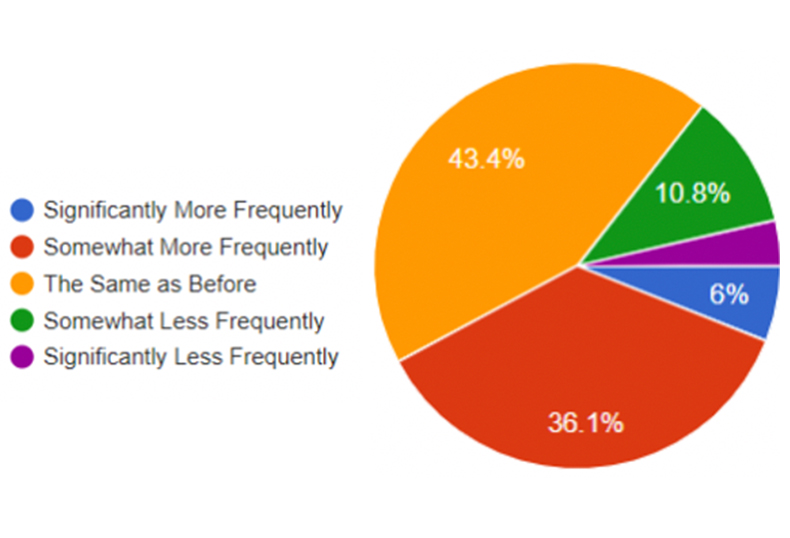
Conclusion
- There was an increase in the frequency of conflict
- Conflicts were over minor issues, as opposed to major
- Comparing conflict resolution style before and during Covid:
- 10% increase in people discussing issue with a calm manner
- Based on open ended responses, the increase was due to there being a quarantine so you don’t have anywhere to escape to
COVID-19 Impacts Friendships for UD Students
College vs. Hometown
Roughly 46% of UD students rekindled old friendships and 40% of students made new friends in the 2020 pandemic. One UD student said in our survey, “I experienced positive developments with my friends from home because I had more time to be able to talk to them whereas when I was at school I would talk more to my friends there.“ During the pandemic the roles of hometown friends and college friends switched and it showed in our survey short answers.
Moving Back Home
“My communication and conflict resolution skills improved with my mom.”
The results showed the majority of students use their time to improve relationships with their family members. People didn’t go into extensive details, but there were multiple responses saying how there was no positive developments. Both findings are significant because results in a study done by researchers showed some people got closer to family members who they had a healthy relationship prior but others increase tensions if they did not have a healthy relationship prior or there were other stresses that had impacted the relationships.
Methods
This information is based on the results of the survey in which 83 UD students a varied academic years answered multiple choice, yes/no and open-ended questions. This survey aimed to investigate UD students’ experiences with friendships during the COVID-19 pandemic quarantine period (March-May 2020).
Closeness
The pie chart analyzing the change in friend group size for respondents that showed if they rekindled friendships during the pandemic 4.8% of the respondents noted they had rekindled an old friendship 15.8 of those responded and said that their friend group became somewhat or significantly larger. 30.8 of respondents said they made new friends during quarantine and noted a somewhat noticeable or significant increase in their friend group suggesting that many respondents did see some positive friendship trends. They didn’t perceive a net positive increase in friendship.
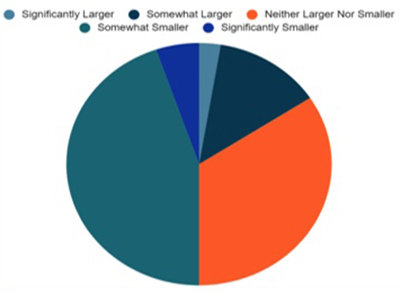
Communications
- 13.3% significantly less
- 67.5% somewhat less
- 19.3% no less
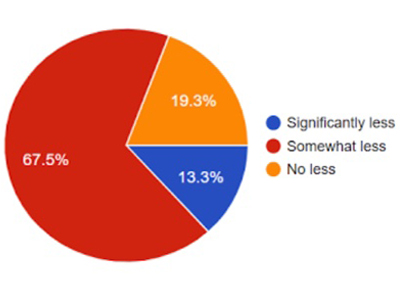
COVID-19’s Impact on Roommate Relationships
Sasha Adams, Sam Aquino, Beckey Carlson-Lee, Alex Miceli, Victoria Te, Hanyu Zhang
Introduction to Survey
There are many individuals who are living through the COVID-19 pandemic. This has caused a lot of relationships to shift. Specifically to students who are currently living on a university campus. This brought up the question “How have the new rules and regulations due to COVID-19 affected conflict and relationships between college roommates?”
Time Spent with Roommates
- Compared responses to two questions asking on a scale of 1-4 how much time (defined as 30 minutes or more) participants spent with their roommates before and during Fall semester.
- Data indicate students are spending more time together.
- 65% of participants responded with 3 or 4 (spending time with roommates almost or every day) before Fall semester.
- 75% responded with 3 or 4 during Fall semester.
Results
When asked “Has COVID-19 been something that directly causes conflict or tension between you and your roommates?” most participants responded yes or sometimes. This indicates that college roommate relationships face more conflict and tension than normal due to COVID-19.
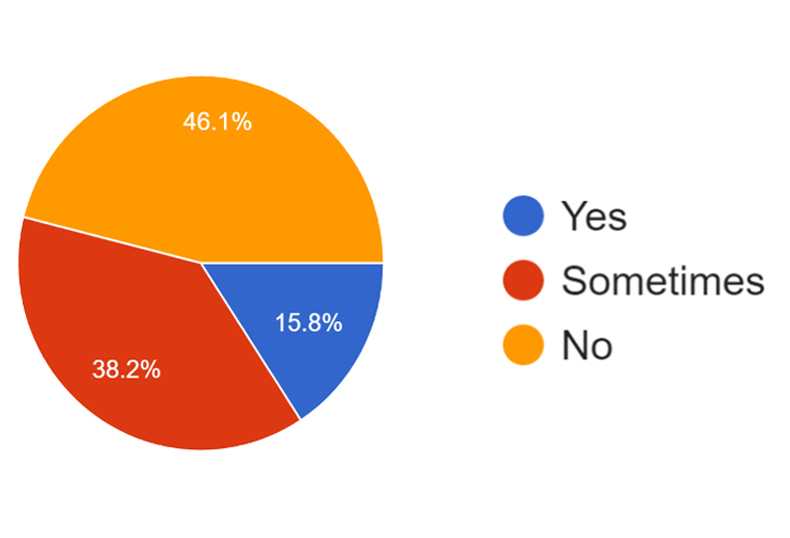
Common Themes
Upon examining the responses to our survey question asking, “please describe examples of conflict and/or tension you have experienced with your roommates during the Fall 2020 semester”, we noticed a few themes:
- First, a lot of conflict stems from personal boundaries. Specifically, every individual has a different level of safety and concern regarding COVID-19, and respecting each other’s boundaries has become difficult.
- Second, lack of communication creates tension in the household at UD. Specifically, not telling your roommate you have been exposed to COVID-19 is dangerous and reckless.
COVID Online: The Influence of Online Technology on Social Interactions During COVID-19
Talia Feldman, Olivia Gmahle, Kristina Holsapple, Maylee Picard, Carlos Ramirez, Keon Wiles
Abstract
Amid the COVID-19 pandemic, changes in relationships due to quarantine and social distancing can be observed through the use of technology to keep in touch. A survey was given to college students to gather data about their online technology use before and during the pandemic. Results show that the use and frequency of use of technology and social media has increased, and relationships have been maintained, yet quality of them hasn’t improved much. It is suggested that future work continue to investigate how relationships beyond college students are influenced by technology.
Motivation and Background
Due to COVID, traditional social support is difficult to achieve (Saltzman et al., 2020). The APA has called for research to be done exploring how technology may “improve the social outcomes of the current pandemic” (Saltzman et al., 2020). Although current work explores social isolation during COVID-19 among older adults (Marston et al., 2020), this work aims to explore how technology contributes to social interactions of college-aged students during the pandemic.
Design
- Population: College students at the University of Delaware
- Methodology: Survey asking online technology impact on relationships
- Data: Quantitative (Likert scale) and qualitative (free-response) questions
Results
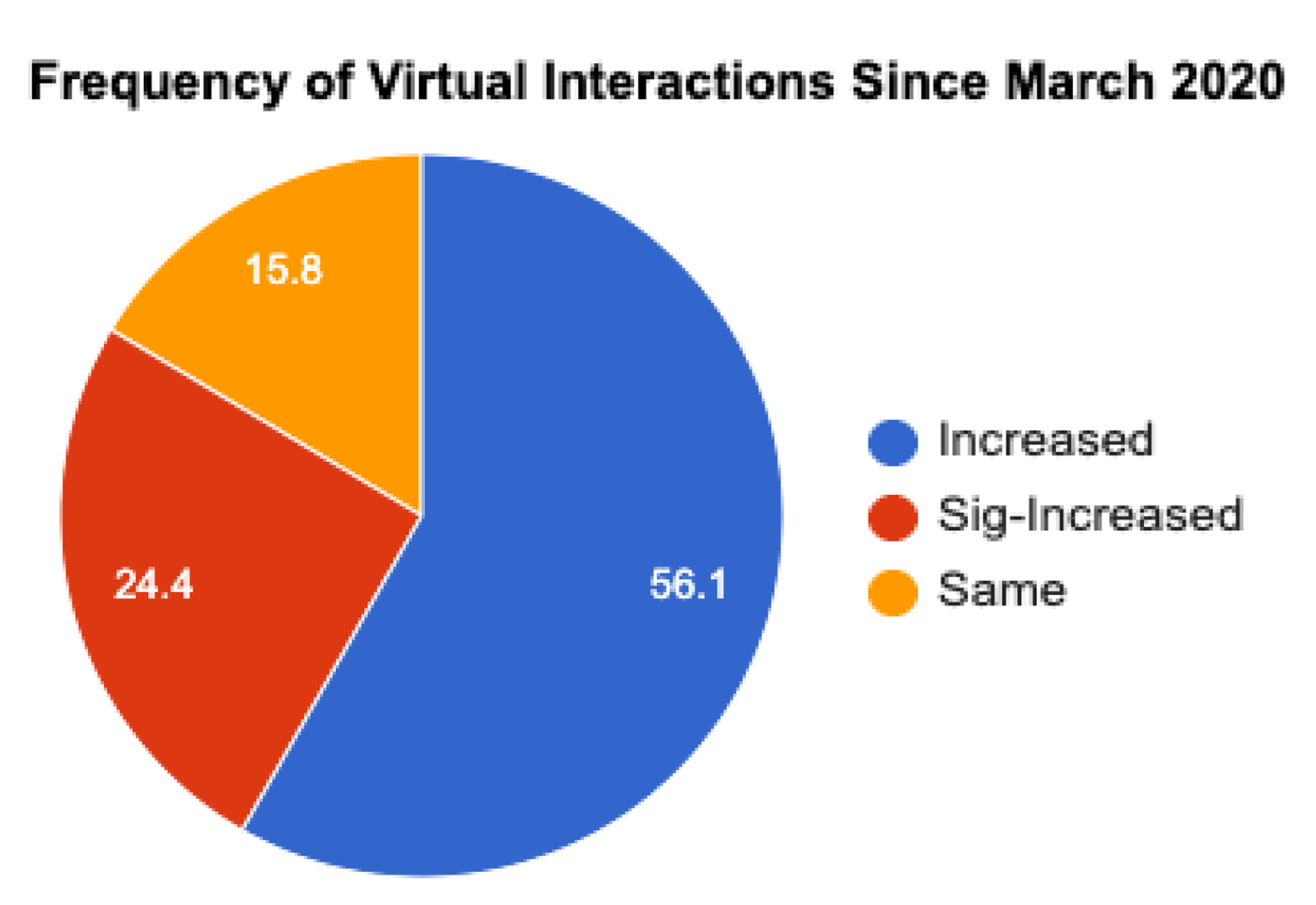
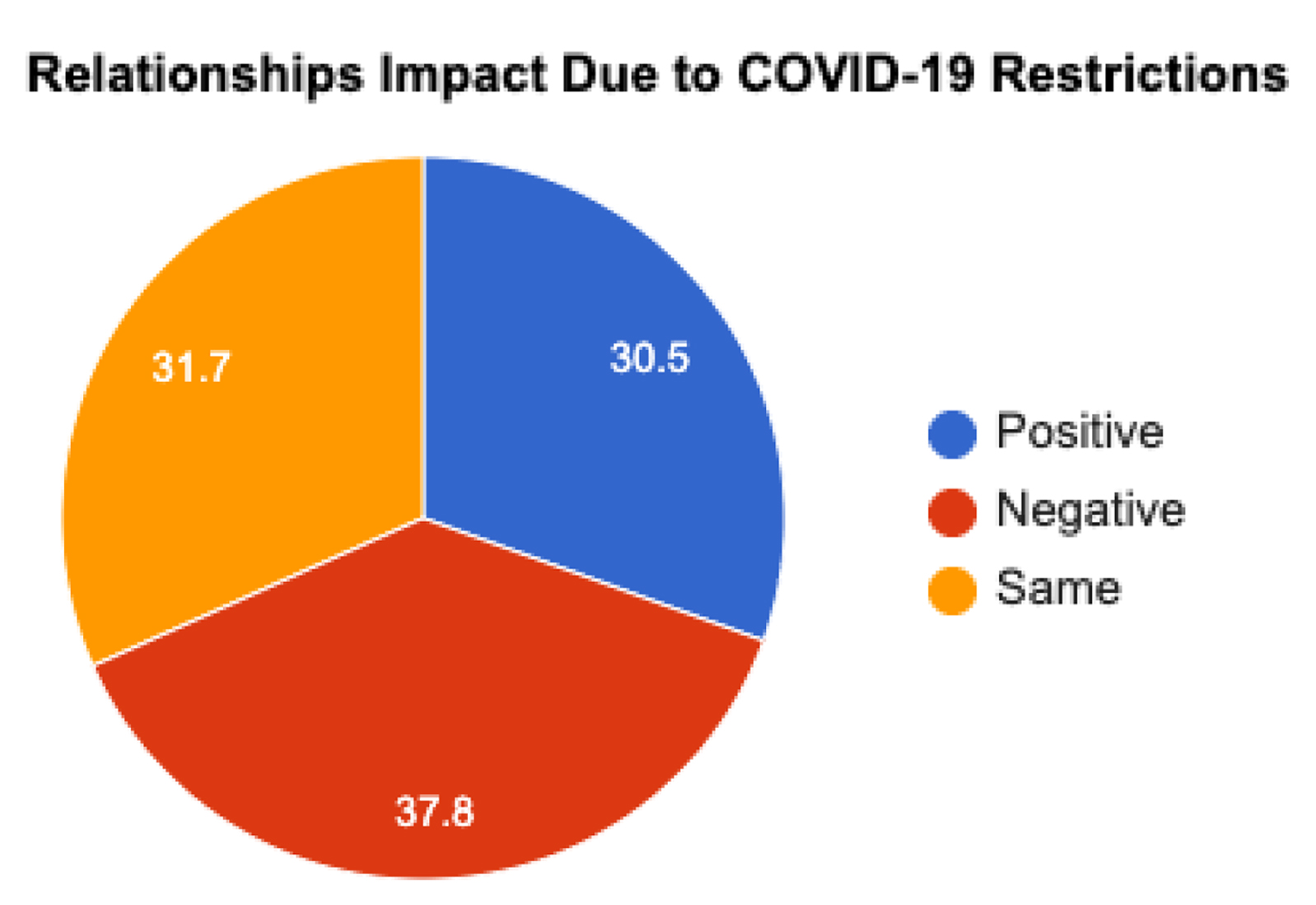
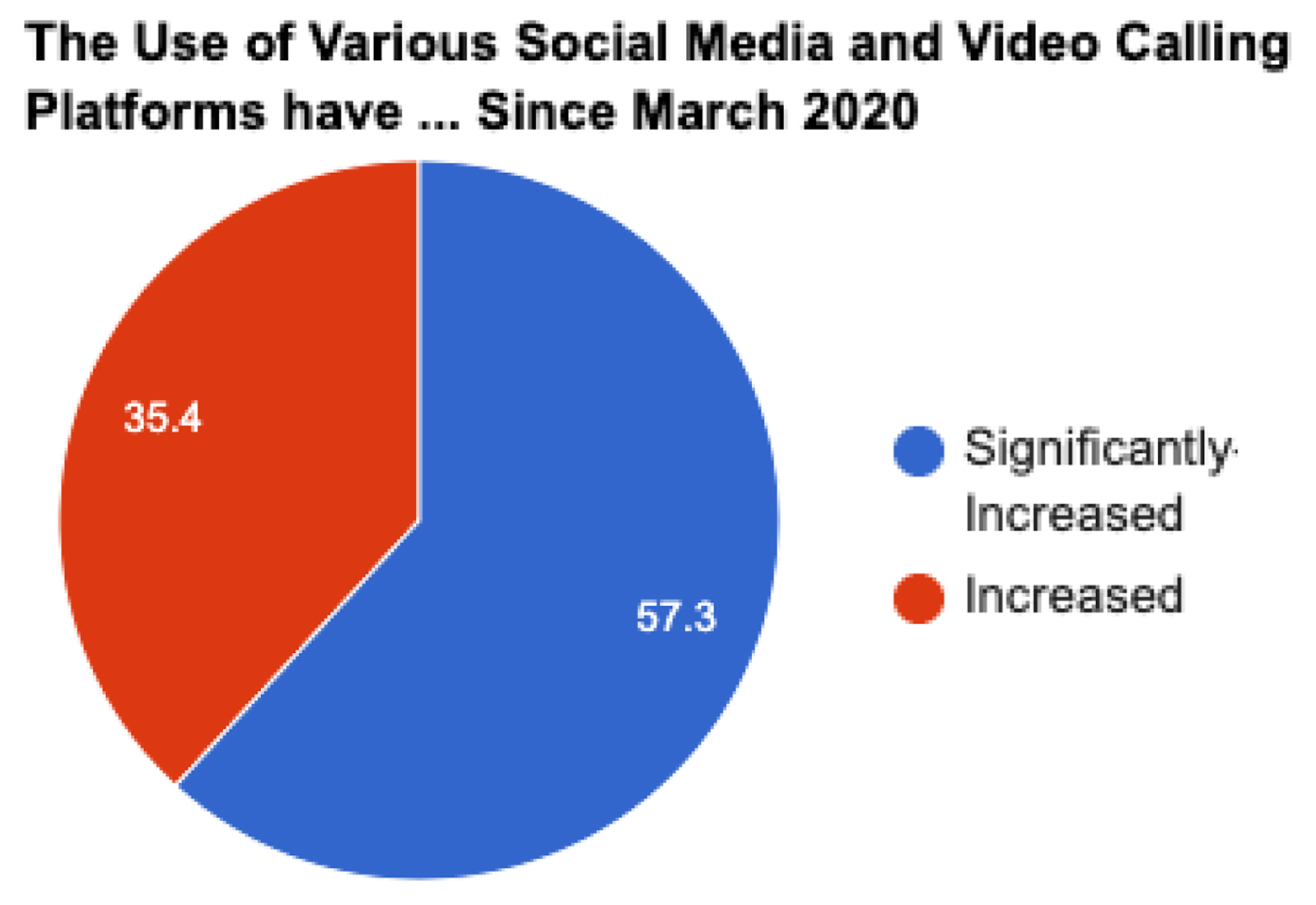
Participant Response
“I really wasn’t a heavy user before the pandemic, but now I would say that I am…social media has allowed me to stay in touch with a wide group of college friends that I would have lost touch with otherwise.”
Evaluation
The population was 90% junior and senior-level college students, 80% female, and over 80% white. The ability to generalize our findings vary due to these demographics.
Conclusion and Future Work
Today’s world has proven that technology and social media have become a prominent means of creating and maintaining relationships. Given the circumstances of the COVID-19 pandemic, our usage of these services has increased, as well as our frequency of virtual interactions. However, this does not mean that the quality of relationships has been maintained. Study participants have reported a decrease in relationship quality and a lack of ability to read social cues and body language virtually. In the future, we suggest continuing research focusing on how relationships of people other than college students are affected by technology, as well as different relationship categories.
COVID-19 Precautions and UD Students:
Ways in which the COVID-19 safety precautions and CDC guidelines have impacted college students and their relationships with roommates
Teresa DeSantis, Adriana Gorgone, Justine Lionti, Diana Marderstein Carly Patroller and Megan Toal
Abstract
Our research examined whether there was a significant interaction between COVID-19 precautions and their motives we found that the stronger their motive was i.e., considering the safety of others, the stronger their precautions were. Many students shared that they valued the safety of others around them, therefore they wore masks and stayed 6 feet away from people not in their home. Our quantitative data shows different precautions that UD students are generally taught taking. Social distancing is the most common answer with 63.8% agreeing that they take this precaution.
Background
We understand that many people have different views, especially because we were all impacted differently which is why we thought it was important to show the regions which participants were from.
Methods
Our survey was constructed on the University of Delaware‘s virtual campus through an online survey.
Results
- “The main precaution I agreed on is that only people we know are allowed in our apartment I agreed to this because our friend group is small and trustworthy when it comes to COVID-19 and being responsible“
- “Being careful who I am within 6 feet and wearing masks with people who are not from my home because I value the safety of my family and do not want anyone to get Covid“
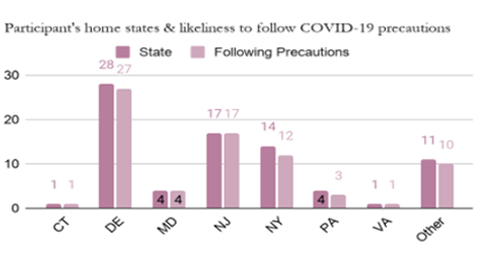
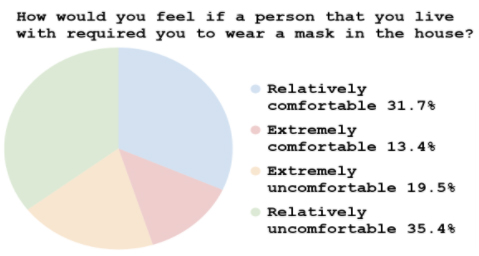
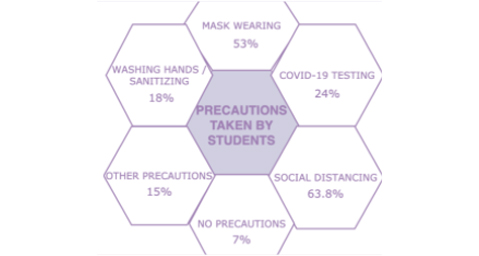
Conclusion
In conclusion through our anonymous survey we were able to draw a conclusion that the stronger the participants motive was the stronger their COVID-19 precautions followed. Our participants were from several different regions but this is consistent throughout. Additionally, our quantitative data shows the different precautions that UD students are generally taking; social distancing is the most common answer with 63.8% agreeing that they take this precaution.
Effects of Remote Learning on Relationships with Classmates and Professors
Abstract
We conducted a confidential survey in which we asked other University of Delaware students about their personal experience with remote learning and how it has impacted their relationships with their professors and classmates. Our data suggests our peers find that forming relationships with their professors and classmates is challenging during this non- traditional learning time.
Background
Many aspects of our lives have changed as a result of the Coronavirus pandemic. Among the many things that have been affected by the pandemic is schooling. School has gone from being held in- person, daily, to being held online, and sometimes only a few days a week. For this survey, 84 University of Delaware students shared how this change has influenced their experience with their professors and classmates.
Methods
Survey questions were created in a Google form, and the form link was emailed to all of our classmates. The demographic of our survey was male and female freshman – seniors in college (with one 5th year student). 84 total responses were recorded in the survey to provide the data. After all data was collected, we created charts by analyzing the quantitative responses and coding the qualitative responses using google sheets. Graphs and charts were compiled from the results in google slides.
Results
- When looking at the first graph, it is easy to see that a majority of students find it very hard to work with others online (36.9%).
- The second graph shows that about 27% of students feel that they are unsuccessful working in groups, and around 20% said it is because there is no face-to-face interaction.
- The third graph shows us that there were 3 answers that most students picked about how comfortable they are working with students in an online format, somewhat comfortable (26.2%), somewhat uncomfortable (21.4%), and neutral (23.8%). This shows that there is no real way to tell the exact level of comfortability between college students working online because of how varied the answers are.
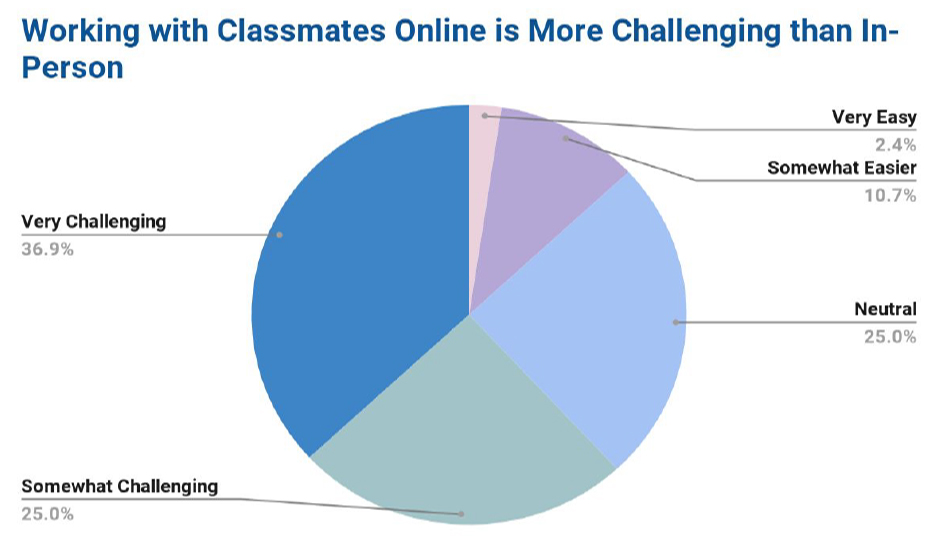
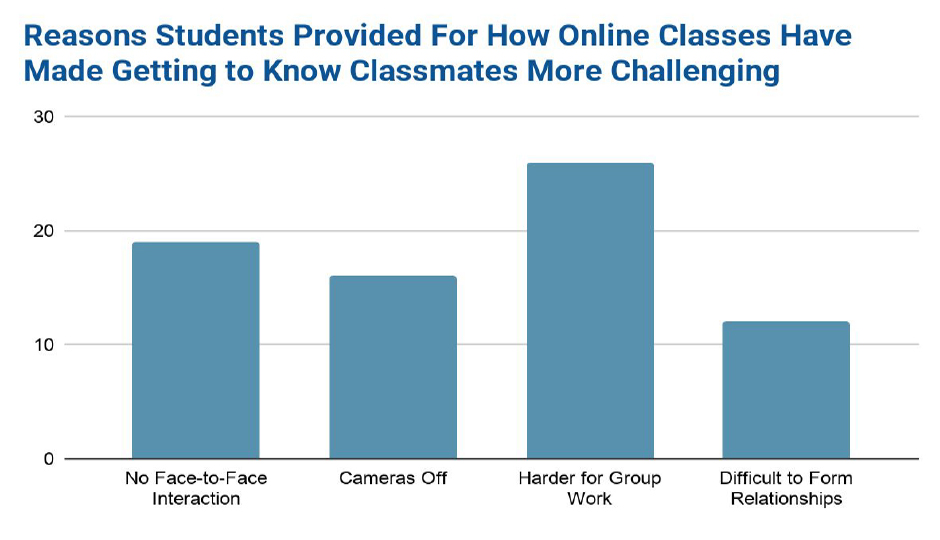
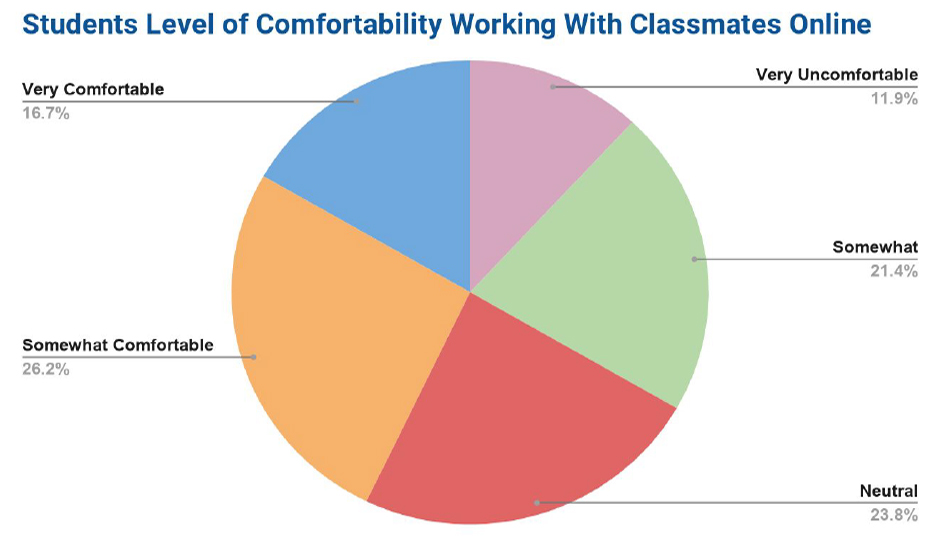
Conclusion
The data does support that relationships during this virtual learning time have been difficult for students with establishing a relationship between their classmates and professors. This was due to students having their cameras off, no face to face interaction, and challenges with working in groups. Questions will continue to arise as our educational delivery continues to be done virtually: How will this affect students when they come back to face-to-face instruction?
How COVID-19 Impacted the Life of College Students at UD
Abstract
- Our main research question explored how the impacts of the stay at home order affected the relationships of household members and what kind of changed occurred.
- Our participants in this study included eighty four University of Delaware students that are enrolled in the Human Development Relationship course.
- The purpose of this study was to identify a correlation between proximity and relationships during the March 2020 stay ay home order due COVID-19
Methods
- Data was collected through a Google Form survey, which included three multiple choice, one scale, and one open ended question.
- Using mixed method research, the coded data was refined by analyzing the qualitative and quantitative data.
Results
- Out of 84 participants, 79.8% went home to their families during quarantine in March 2020.
- 71.4% of participants said that they communicated frequently with the members in their household prior to March of 2020. 26.2% communicated on occasion prior to quarantine.
- 32.1% agreed that they grew closer with one member of their household compared to others during quarantine and 19% strongly agreed.
- 58.3% of participants planned fun activities to do together with members of their household, which included cooking and baking together.
- Some common themes of how household dynamics changed to COVID were the following: open communication, and spending time together, and appreciation of household members.
During the March-May 2020 COVID-19 quarantine, the members of my household and myself were bonding more by participating in activities together. (84 responses)
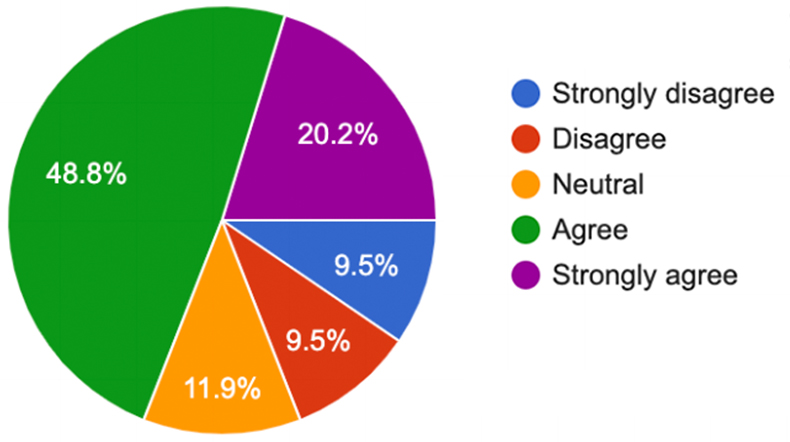
Conclusion
Through the survey answers we can conclude that, overall, there were more positives that occurred between household members than negatives. This proves that the majority of people think the quarantine positively impacted their relationships with their household members.
The Impact of Headaches on the Quality of Relationships Since March
Noelle Briguet, Emily Virok, Julia Schwartz, Nicole Scacco, Sara Dooley, Abby Stein
Abstract
- Our topic was driven by the fact that we all suffer from headaches.
- The purpose of our study was to see the impact that headaches have on the quality of relationships and interactions since the start of COVID-19.
- We first looked into existing literature to see the impact headaches had on relationships and found scientific support for a trend in headache increases as a result of pandemic stress.
- We wanted to look into whether people from our class had similar experiences to what the research shows.
Methods
- We were aligned around this one topic that is prevalent based on our personal experiences.
- To collect data, we utilized google forms to ask survey questions based on a likert scale to assess the frequency of headaches and changes in the quality of interactions.
- In addition, we incorporated an open ended question to gather more detailed qualitative responses.
- To analyze our data, we color coded the various responses we received based on the Likert scale, found common themes from our qualitative data, and generated representative graphs.
Results
- Figure 1
- 69.1% of participants experienced at least 3 headaches per month14.7% of participants experienced 10+ headaches per month
- Figure 2
- 17% of the responses were coded as “no impact”.
- This indicates that 83% of the responses showed changes in the quality of relationships.
- 18% of the responses demonstrated a decrease in motivation to socialize or interact with others.
- Figure 3
- Impact of screen time by headache frequency was our most significant research finding.
- All participants who experienced 6+ headaches per month reported their headaches being intensified by increased use of computer screens and/or phone screens.
- This shows a positive correlation between increased screen time and increased intensity of headaches.
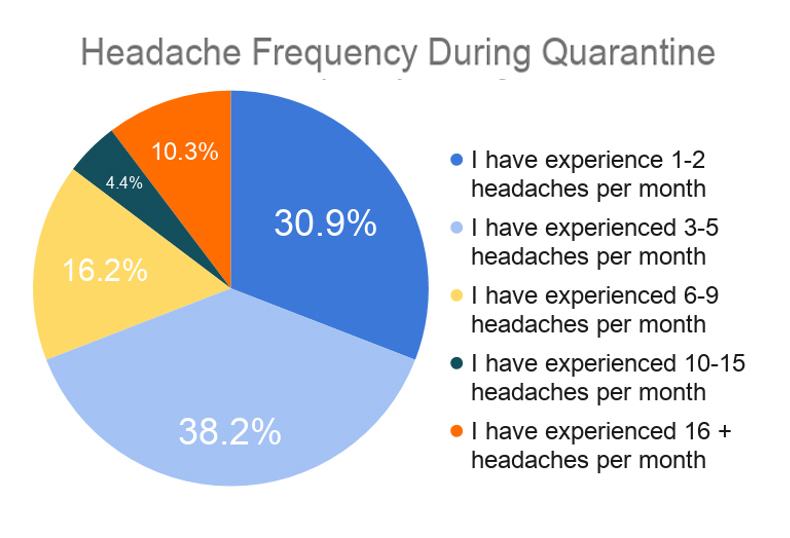
Figure 1
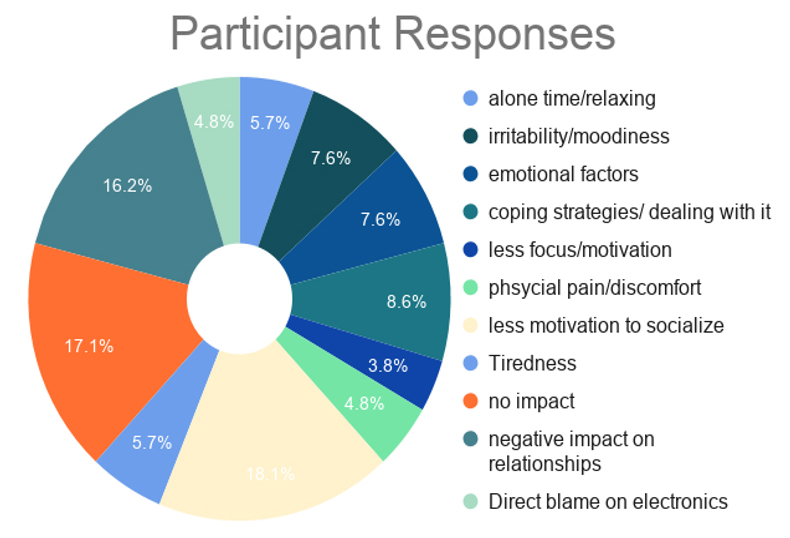
Figure 2
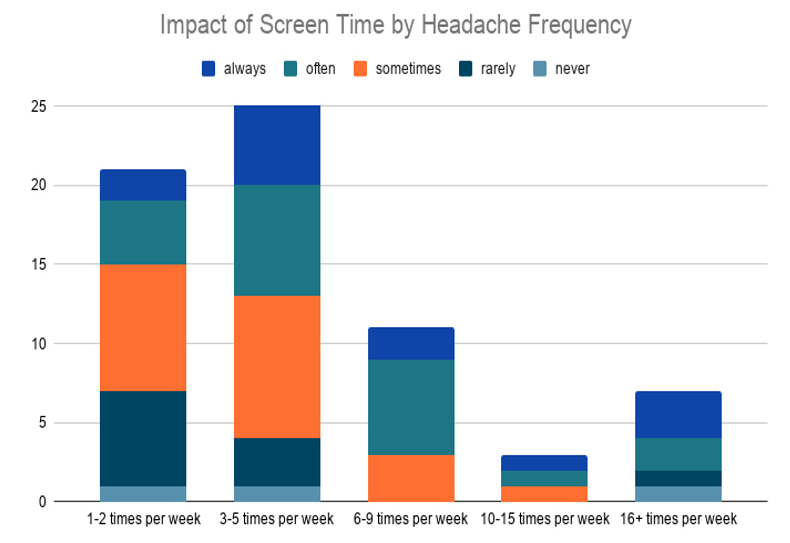
Figure 3
Conclusion/Future Questions
- This is a prevalent issue amongst our class.
- Future research should be conducted to generalize our findings to the broader population.
- It is important to understand as the pandemic worsens and more lives are impacted.
Lifestyle in the Q; Understanding Household Members Influence on One Another’s Lifestyle Habits During COVID-19
Victor Avilles Gonzales, Ellen Gallagher, Rob Lotito, Victoria Ochlan, Eiliana Schulman
Abstract
Quarantine during COVID-19 March 2020 through May 2020 was a time of adjusting and adapting and many people went through big lifestyle changes. We conducted a survey to see how many people living together during quarantine impacted one another’s lifestyle habits (exercise, eating, self-care). All participants are college students the majority of whom have lived at home with their families during this time.
Workout/Exercise/Fitness Habits Change During Quarantine
- Individually
- “I begin working out during the quarantine”
- “Taken on exercise and meditation during quarantine”
- With Members of Household
- “Improved our physical health which helped to improve mental health”
- “We took walks together at the beginning of quarantine”
- “I think my family decided to start taking more care of their bodies”
- “My family members share the Peloton workouts we compete with one another”
Eating Habits Change During Quarantine
-
Better eating habits
-
“Stopped eating out as much”
-
“Tried new healthy recipes together”
-
-
Worse eating habits
-
“Overall, I’ve been affected by my parents’ eating habits the most… I would much rather eat highly nutritious food for building muscle, but I currently have no money so I cannot complain or refuse food.”
-
“We encouraged each other’s eating habits in a bad way because we could not stop baking.“ “We would eat more junk food while stuck in the house.”
-
New Lifestyles Picked Up During Quarantine
- New lifestyles picked up during quarantine from people living in household
- 58 out of 83 people picked up walking
- 44 out of 83 people started cooking
- 23 out of 83 people started weightlifting
- At this time how often do you practice these lifestyle habits?
- 61.4% practice these have it several times a week
- 15.7% at least one time
- 22% every day
Conclusion
A majority of survey respondents agreed that who they were quarantined with had an impact on their lifestyle habits and vice versa. A large group of responses shows an increase in bonding activities such as shared meals and exercising together. Respondents found that they were more motivated and influenced by those they were living with to practice these healthier lifestyle habits. These new habits that were practice together led to many of the survey respondents saying that they have experienced a stronger and growing relationship with other household members during the quarantine.
Long-Distance Relationships: How COVID-19 is Impacting Family
Brooke, Ally, Kate, Nasir, Jess and Lizi
Abstract
- Observed an increased dependency on technological means as a mode of communication with family members due to the pandemic
- Explored how travel restrictions and physical distancing measures impacted quality of long-distance relationships
- Large majority reported experiencing less or similar amounts of connectivity
Methods
- Five questions devised: mix of quantitative and qualitative
- Approaches achieve measurable data and deep analysis
- Distributed to students in HDFS333-010
- Focus on relationships with extended family and the impact of COOVID-19
- All answers kept confidential
Results
-
Under normal circumstances:
-
39% of participants visit their long distance family members 0-1 times per year
- 37.8% visit them 2-4 times per year
- 23.2% visit them greater than 4 times per year
-
- Since COVID-19:
- 76.8% visit their long distance family members 0-1 times per year
- 22% visit them 2-4 times per year
- 1.2% have visited them greater than 4 times per year
- Shows a 37.8% increase in people who have visited their long distance family members 0-1 times per year since COVID-19
- 41.5% of people feel less connected to their long distance family members or they feel that their relationship isn’t the same
- 26.8% reported feeling more connected and 59% of those people have mentioned technology being helpful in feeling more close with those family members
- 31.7% of people reported having no change in connectedness with long distance family members
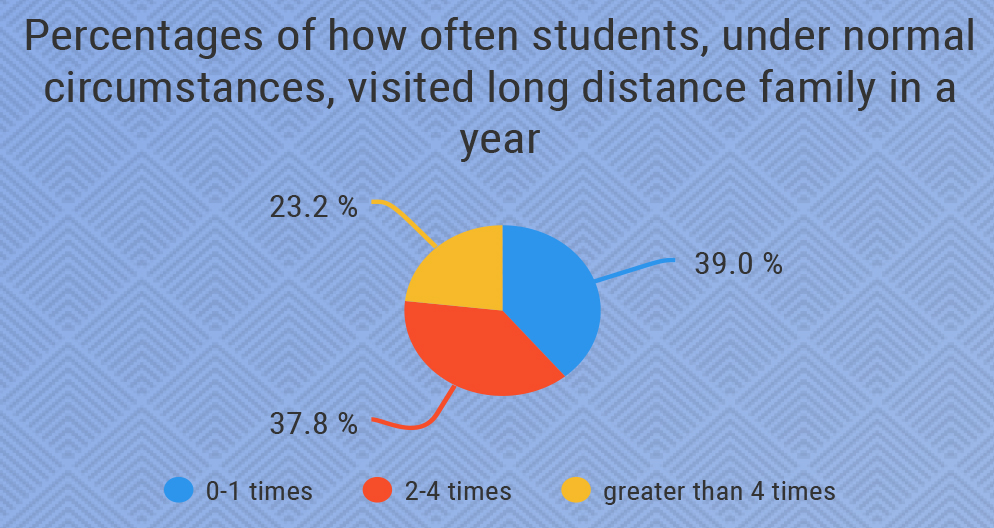
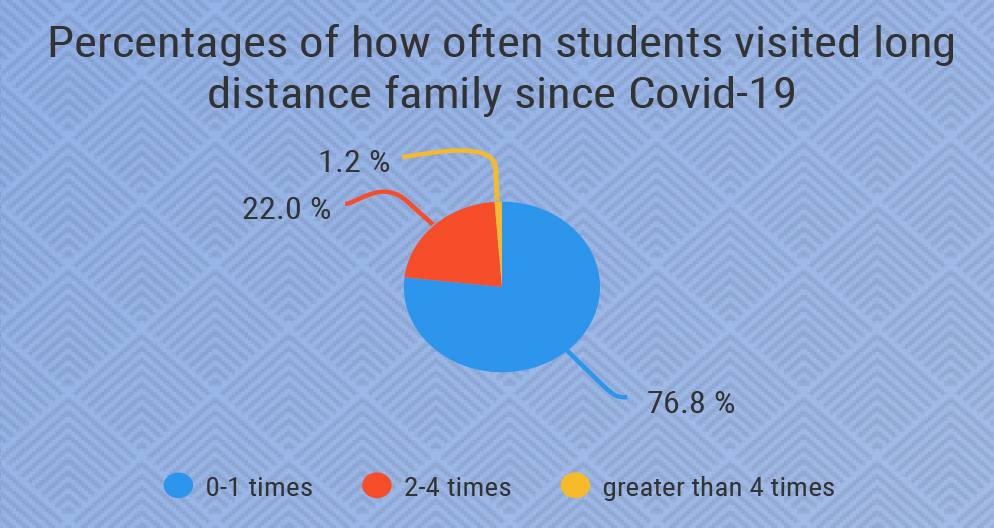
Conclusion
- Initially thought relationships between students and their long distance family members would have significantly changed due to COVID-19
- Chosen research population was a total of eighty-two college students at the University of Delaware
- Results of our survey show that a good amount of students felt either less connected or had no change in connection with their long distance family members due to the pandemic
- Social media and technology played a role in connectivity between students and family
Parental Figures in the Pandemic
How does the coronavirus pandemic impact relationships between college students and parental figures?
Gabrielle Attenzia, Cindy Peterson, Michelle Emig, Lani Mason, Izzy Battaglia, and Bryce DiMedio
Abstract
The relationship between parental figures and their college-age students during the COVID-19 pandemic was examined 82 University of Delaware students participated approximately 80% identifying as female, 20% as male and all were students in HDFS-333; Development of Human Relationships. Through this study the pandemic was found to have a significant impact on parental figure relationships, whether that be positive or negative. In general, it emphasizes the state of the relationship that existed before the pandemic. This relationship was overall affected majorly by proximity. There was a correlation between distance of family and the intensity of relationship change.
Methodology
The methodology of this study was done by presenting an anonymous survey to members of HDFS-333 course. Basic demographic information was collected, such as graduation year and the students living certain situation during quarantine that began in March 2020. The survey was sent electronically and participants self-reported their answers to demographic questions, rating scales, and open-ended questions after the data was collected it was analyzed for trends and overarching themes. Statistics were also extracted from the survey data in order to convey a full picture of the sample.
Hypothesis
Our team hypothesizes that COVID-19 had major effects on parent figure relationships with college students. Furthermore, the prediction includes the idea that changes weather in communication or closeness can be positive or negative depending on the individuals pre-existing relationship with the parental figures. We predict that students experience a range of strong emotions and that those emotional reactions could impact their relationships of the family. Third if students are at home for an extended amount of time then there could be familial tension and arguments damaging the pre-existing relationships within the household.
Participants
The participants in the study were all students of the University of Delaware in the course development of human relationships. They were 82 respondents. 80% identified as female, 90% were students in their junior or senior year.
Results
When students were asked to rate their agreement with the statement: communication with my parent figures change during the quarantine, most students agreed that some change in communication had taken place in addition when asked about how the communication changed, there was a pattern of close proximity. This meaning, if one was located at a home with their parental parents and there was a significant impact on how they answered the question.
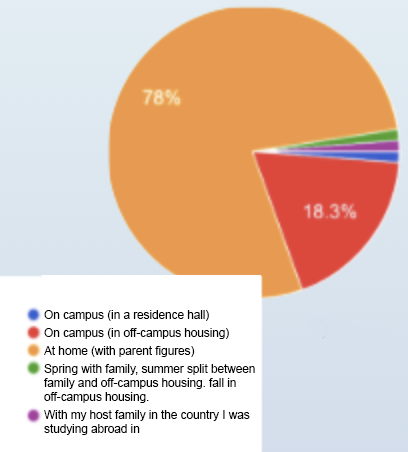
Figure 1
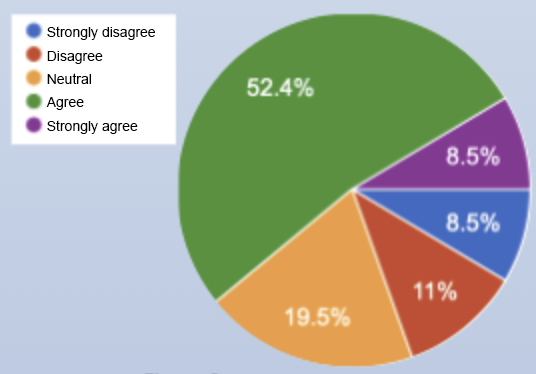
Figure 2
Conclusion
After reviewing survey results, the data shows the pandemic had significant impacts on parental figure relationships. First there is a clear link between the proximity of parents and figure and a degree of relationship of change as shown in figure 178 of respondents it’s been quarantine at home with their parent figures. We also noticed that relationships were enhanced based on the previous state of the relationship. For instance, previously positive relationships became more positive and previously negative relationships became more negative. Another interesting finding was that the connection between students who were able to find a relaxing time to themselves and those who did not have that opportunity. Students with “me time“ tended to support report less changes in communication and experience a more stable and healthy mental state.
Social Media and COVID-19
Eve Bisaccia, Abby Cassalvera, Faith Munkholm, Zack Stickland, Jon Tressler, Carly Zakarin
Abstract
In a 2019 statistica.com survey, it was reported that 90% of 18 to 29-year-olds use social networks. Younger generations use social media as their main form of communication; when a worldwide pandemic hit in March of 2020, it seemed inevitable that there would be an increase or change in social media use during quarantine. This can be attributed to the lack of in-person interaction with people outside of an individual’s immediate household. The purpose of this study was to examine the impact of social media use on family and friend relationships since March of 2020.
Methods
We decided to research the impact of social media during COVID-19 since March 2020. To study this topic, we created a survey consisting of seven questions. The questions asked the participant about gender, school year, impact of social media, amount of time spent on social media, relationship with friends/family through social media, and time spent away from social media while with friends/family. Each of the questions was put on a Likert scale, with the exception of the last question, which was open-ended. We administered this survey to 81 of our classmates in our Development of Human Relationships class through a Google Form.
Results
“I feel it hindered my relationships because I would get so bored during quarantine all I would do was use screen time to check socials. So now I have to remind myself when I am with family or friends to put my phone down and just enjoy the time with them.”
“Social media has helped me to stay more connected with my family and friends. Many of my college friends live very far away from me so I did not see them over quarantine. Through Facetime, texting, and Snapchat I was able to still stay close with them.”
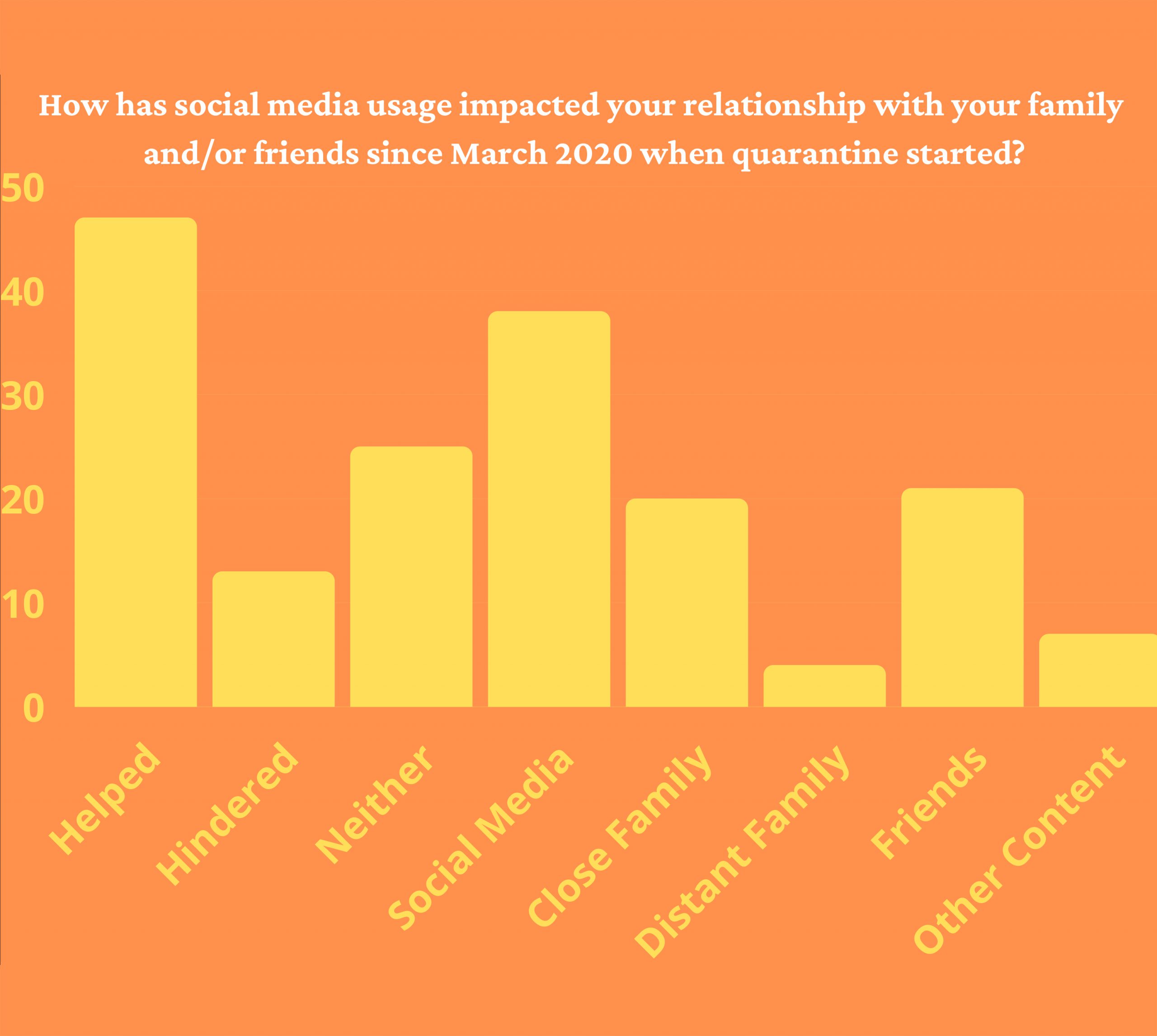
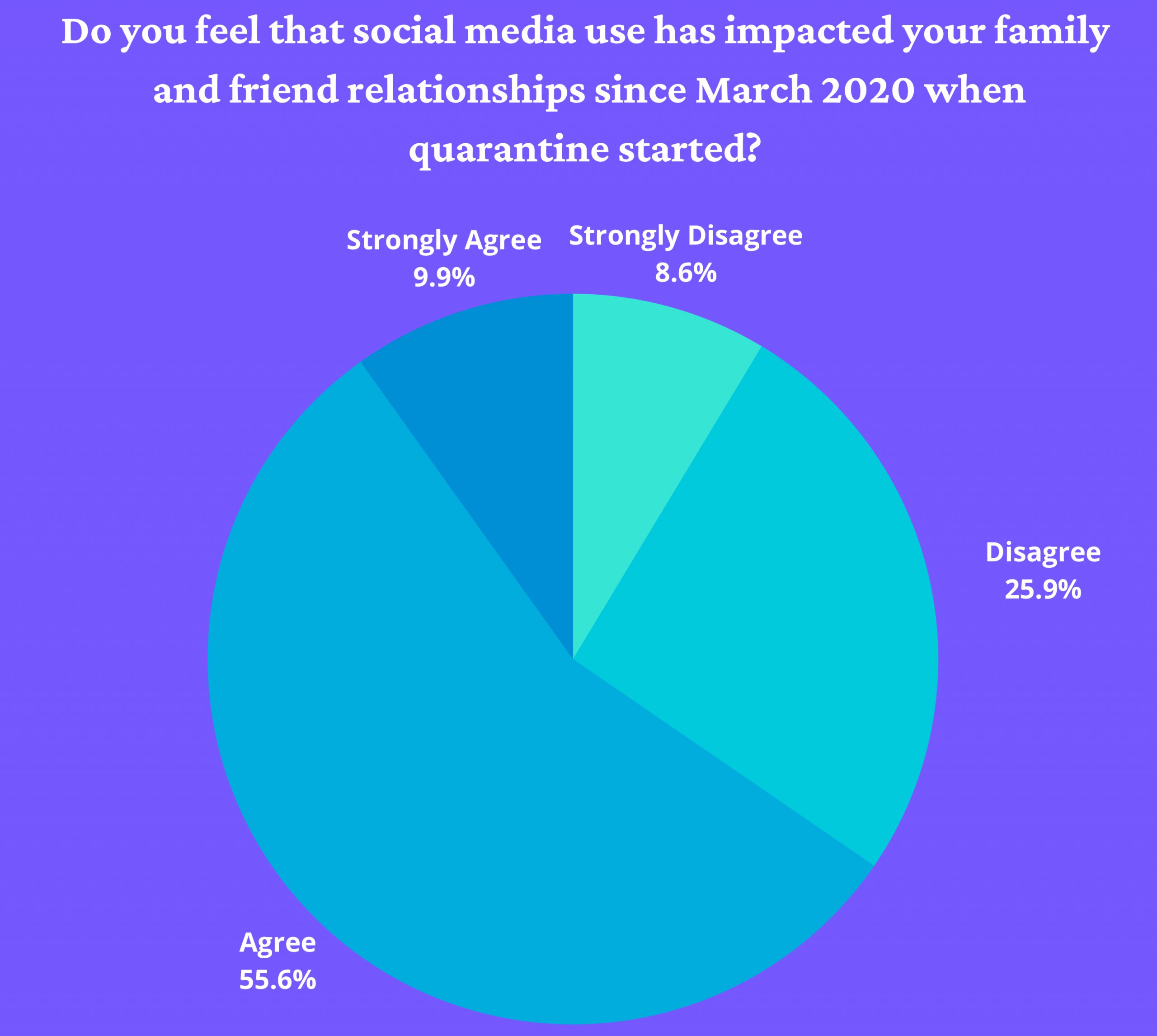
Conclusion
We found that a majority of people used social media in order to keep themselves in the loop with their family and friends that they weren’t able to see during the quarantine period. Additionally, we saw that social media apps and electronic communication was really effective for most people to stay connected. However, we did receive a number of responses from students that reported that social media made things more difficult for them and sometimes made them feel even lonelier than they were already feeling. With these results, we will take the next steps to make people aware of this information. This information may allow for others to use social media in a more productive way.
Student Professor Relationships Through Online Learning Platforms
Caitlin Bobis, Audrey DiBartolomeo, Joy Kim, Matt Juvelier, Veronica Perez, Emma Warhol
Abstract
Due to the transition to online learning, we wanted to investigate how this new format impacted student-professor connectedness. We defined the level of connectedness by whether or not students have established some kind of relationship with their professors both in and out of the class setting. The degree to which barriers (i.e., interfering obstacles) of online learning were perceived to be related to comfort and the levels of connectedness within a professor and student relationship.
Background
Earlier this year, as a result of the current pandemic, schools across the nation were forced to shut down and quickly transition into an online format. At the University of Delaware specifically, online classes were divided into asynchronous and synchronous formats, with very few classes being taught in person. As a result, teachers and students alike have been struggling to adjust and maintain the relationships that once came easily in a classroom setting.
Methods
- Data Collection: This research analyzes data from an online survey using Google Forms. The data consists of 82 responses from a demographically representative college class.
- Analysis: The data was analyzed using a coding system consisting of parent and child codes. The parent codes included: less connected, more connected, and no difference in connection with professors. The child codes included: more comfortable/less comfortable with participation, minimized interaction/enhanced interaction/no change in interaction, and more challenging/less challenging.
Results
- Technology has become a barrier for online learning. 62.2% would rather participate in person and 36.3% would prefer utilizing zoom to participate.
- Our statistics show that 98.8% of students find their professors to be friendly. However, 50% of students do not feel connected to their professors.
- 90 percent of students say that having a strong relationship with their professor leads to greater academic success. However, 50% of students do not feel connected.
Research Question: Has online learning created experienced barriers for UD student-professor relationships?
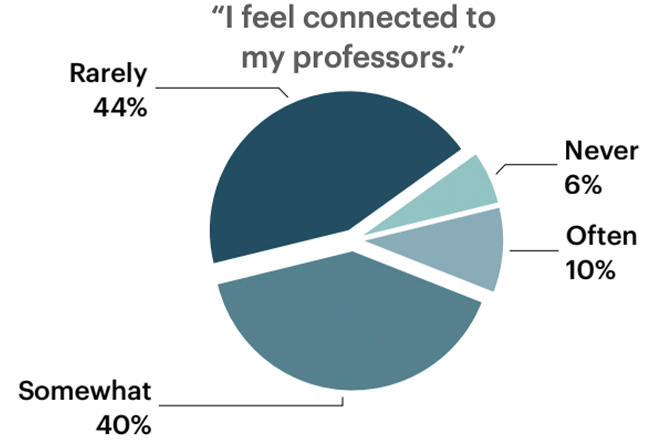
Conclusion
Most students felt that online learning has created barriers such as minimized interaction, more discomfort participating over Zoom, and more challenges in getting to know the professor which ultimately resulted in a feeling of disconnect between students and professors. Students who feel more connected to their professors face less barriers in online learning and are more likely to participate more in class. Our results also show that gaining a strong knit relationship with a professor leads to academic success and motivation. Lastly, friendliness does not lead to a higher level of connectedness.
Virtual Learning, Emotions, and Relationships in College Students During COVID-19
Amato, A., Mena, D., Mennella, H., Venditto, G., Winward, J.
Abstract
The novel coronavirus (COVID-19) pandemic has lead many institutions to transition to virtual instruction, including the University of Delaware. This survey-based research aims to examine the dramatic impact this shift has had on college students’ emotional states and relationships. The results showed that students are spending more time using technology, feeling negative emotions more frequently, and feeling less connected.
Methods
- 5 question anonymous survey
- Distributed to 84 students in HDFS 333 through email
- 3 multiple choice questions, 1 checkbox selection, and 1 open-ended response
Results
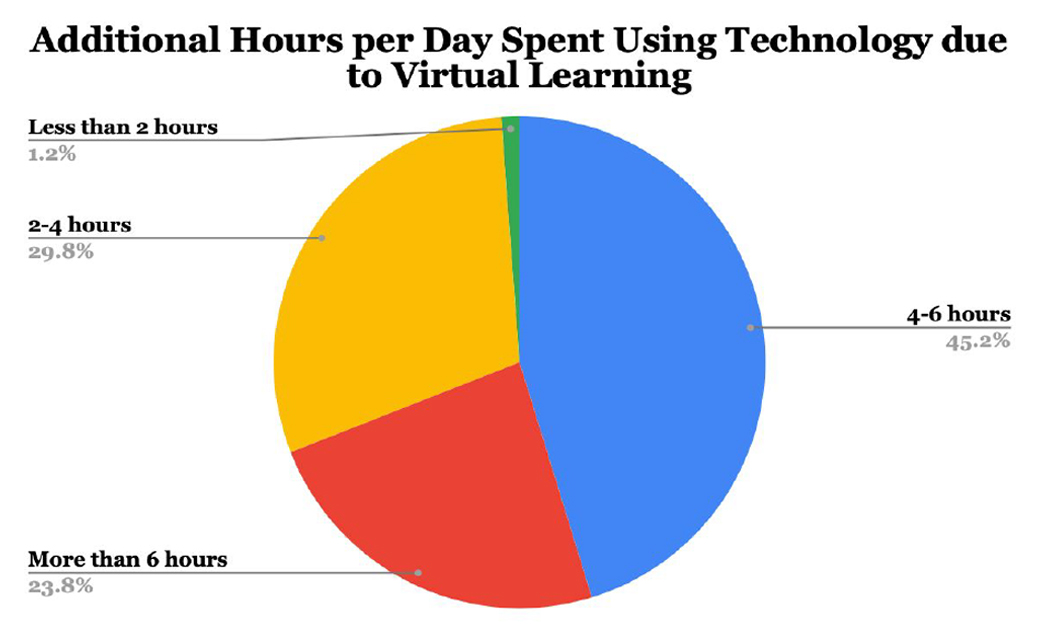
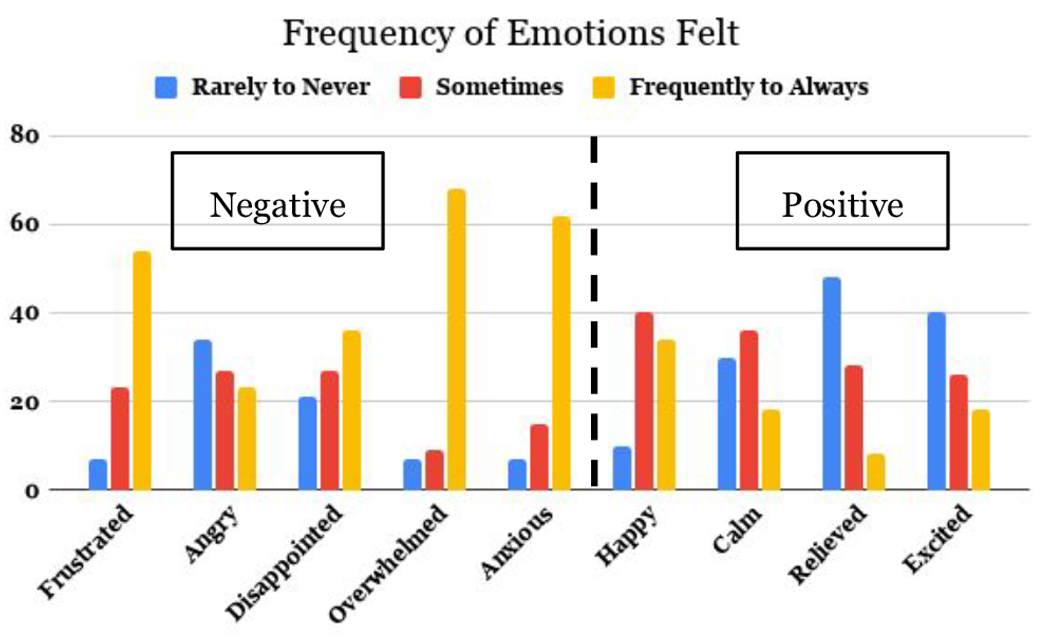
Themes in Responses to “In what ways have distanced learning and technology been influencing your relationships during the COVID-19 pandemic?
“It feels harder to have a more in depth conversation or relationship. It all feels very surface level.”
“I know that I am always able to talk over the phone or using some type of technology, but it does not feel the same as actually interacting in person.”
“Distanced learning has weakened my friendships, but technology has strengthened them.”
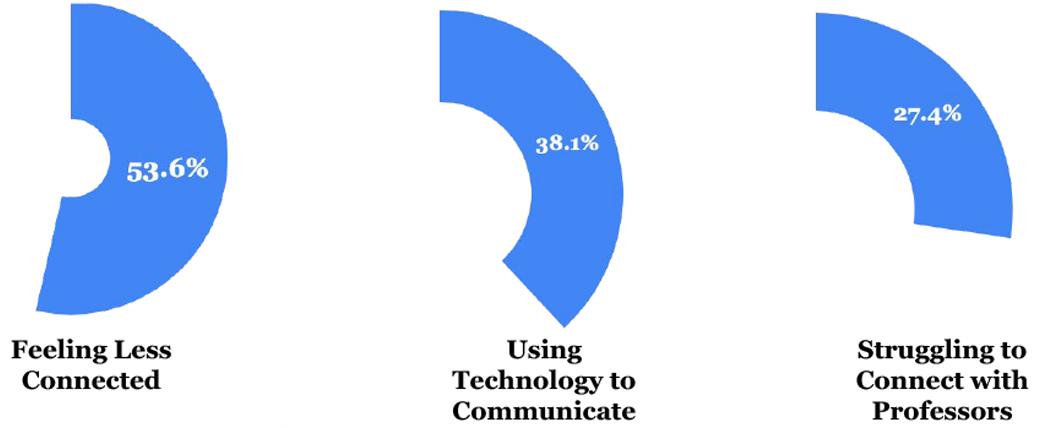
Conclusion
- Students have spent significantly more hours using technology since the start of virtual learning.
- Virtual learning in the pandemic has increased the frequency of experiencing negative emotions.
- Students are feeling less connected.
- Further research could be done about the long term positive and negative effects of technology use during the pandemic.
